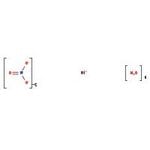Search Thermo Fisher Scientific
Nitrate de nickel(II) hexahydraté, Puratronic™, 99,9985 % (base de métaux), Thermo Scientific Chemicals



Nitrate de nickel(II) hexahydraté, Puratronic™, 99,9985 % (base de métaux), Thermo Scientific Chemicals
Identifiants chimiques
Spécifications
Description
This Thermo Scientific Chemicals brand product was originally part of the Alfa Aesar product portfolio. Some documentation and label information may refer to the legacy brand. The original Alfa Aesar product / item code or SKU reference has not changed as a part of the brand transition to Thermo Scientific Chemicals.
Figures
Documentation et téléchargements
Certificats
Foire aux questions (FAQ)
Citations et références
Sécurité et manipulation
Classification of the substance or mixture
CLP classification - Regulation(EC) No 1272/2008
Label Elements
Signal Word
Danger
Hazard Statements
H302 + H332 - Harmful if swallowed or if inhaled
H315 - Causes skin irritation
H317 - May cause an allergic skin reaction
H318 - Causes serious eye damage
H334 - May cause allergy or asthma symptoms or breathing difficulties if inhaled
H341 - Suspected of causing genetic defects
H350i - May cause cancer by inhalation
H360D - May damage the unborn child
H372 - Causes damage to organs through prolonged or repeated exposure
H410 - Very toxic to aquatic life with long lasting effects
Physical Hazards
H272 - May intensify fire; oxidizer
Precautionary Statements
P201 - Obtain special instructions before use
P210 - Keep away from heat, hot surfaces, sparks, open flames and other ignition sources. No smoking
P273 - Avoid release to the environment
P280 - Wear protective gloves/protective clothing/eye protection/face protection
P308 + P313 - IF exposed or concerned: Get medical advice/attention
P405 - Store locked up
Additional EU labelling
Restricted to professional users